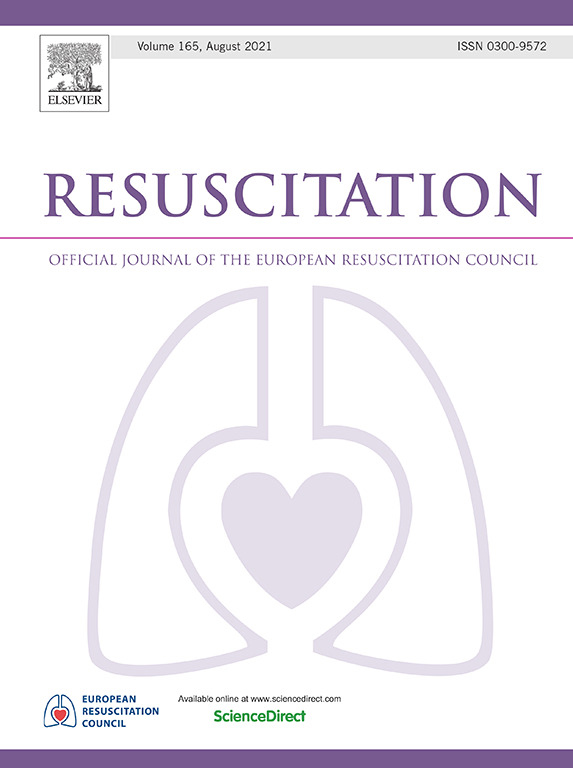Interleukin 6 blockage alters the plasma metabolome in out-of-hospital cardiac arrest
IF 4.6
1区 医学
Q1 CRITICAL CARE MEDICINE
引用次数: 0
Abstract
Background
Comatose patients resuscitated from out-of-hospital cardiac arrest (OHCA) exhibit a systemic inflammatory response, as indicated by elevated interleukin-6 (IL-6) levels, which is associated with increased mortality. Tocilizumab, an IL-6 receptor antagonist that reduced C-reactive protein response and markers of myocardial injury in a phase II OHCA trial.
Aim
To describe the early effects of tocilizumab on circulating levels of metabolites in comatose patients resuscitated from OHCA.
Method
Patients from the phase-II double-blinded randomized trial (NCT: 03863015) were included in this substudy. A total of 85 comatose patients resuscitated from OHCA were randomized at the time of arrival to the hospital to either tocilizumab 8 mg/kg or placebo, of which 80 received the intervention and did not later withdraw from the study. Plasma samples before randomization and 48 h later were analyzed by a targeted metabolomics approach quantifying 60 circulating metabolites.
Results
Of 80 enrolled patients (median age 62 years (IQR: 54–72), men 66 (83 %)), 39 were randomized to tocilizumab group and 41 to placebo. Comorbidities and cardiac arrest characteristics were overall well-balanced. At hospital arrival, levels of metabolites from the tricarboxylic acid (TCA) cycle were associated with time to return of spontaneous circulation and independently with early levels of IL-6 (all p < 0.05). The early levels of medium-chain acylcarnitines were associated with age, NT-proBNP, estimated glomerular filtration rate, and marker of neurological injury (neurofilament light chain) (all p < 0.01). At 48 h, tocilizumab increased the levels of plasma amino acids, especially threonine, glycine, and serine, by more than a factor of 1.5 (p < 0.01). Two eicosanoids 15(S)-HETE and 12(S)-HETE were 1.9 times higher (p < 0.01).
Conclusion
Blocking the IL-6 receptor with tocilizumab early after OHCA impacts circulating metabolites, particularly those within the glycine, serine, and threonine pathways, highlighting the connection between acute systemic inflammation and metabolism. Further, early levels of TCA metabolites are independently associated with early inflammatory response and early medium-chain acylcarnitine with later markers of neurological injury.
阻断白细胞介素 6 可改变院外心脏骤停患者的血浆代谢组。
背景:院外心脏骤停(OHCA)昏迷患者复苏后会出现全身炎症反应,表现为白细胞介素-6(IL-6)水平升高,这与死亡率升高有关。托西珠单抗是一种IL-6受体拮抗剂,在II期OHCA试验中可降低C反应蛋白反应和心肌损伤指标。目的:描述托西珠单抗对OHCA昏迷复苏患者循环代谢物水平的早期影响:方法:本子研究纳入了II期双盲随机试验(NCT:03863015)的患者。共有 85 名因 OHCA 而复苏的昏迷患者在抵达医院时被随机分配至托珠单抗 8 毫克/千克或安慰剂,其中 80 人接受了干预且后来没有退出研究。随机化前和48小时后的血浆样本通过靶向代谢组学方法进行了分析,量化了60种循环代谢物:80名入选患者(中位年龄62岁(IQR:54-72),男性66人(83%))中,39人被随机分配到西利珠单抗组,41人被随机分配到安慰剂组。合并症和心脏骤停特征总体上非常均衡。到达医院时,三羧酸(TCA)循环代谢物的水平与恢复自主循环的时间相关,并与早期IL-6水平无关(均为p):在 OHCA 后早期使用托西珠单抗阻断 IL-6 受体会影响循环代谢物,尤其是甘氨酸、丝氨酸和苏氨酸途径中的代谢物,这突显了急性全身炎症与代谢之间的联系。此外,早期 TCA 代谢物水平与早期炎症反应和早期中链酰基肉碱与后期神经损伤标志物之间存在独立关联。
本文章由计算机程序翻译,如有差异,请以英文原文为准。
求助全文
约1分钟内获得全文
求助全文
来源期刊

Resuscitation
医学-急救医学
CiteScore
12.00
自引率
18.50%
发文量
556
审稿时长
21 days
期刊介绍:
Resuscitation is a monthly international and interdisciplinary medical journal. The papers published deal with the aetiology, pathophysiology and prevention of cardiac arrest, resuscitation training, clinical resuscitation, and experimental resuscitation research, although papers relating to animal studies will be published only if they are of exceptional interest and related directly to clinical cardiopulmonary resuscitation. Papers relating to trauma are published occasionally but the majority of these concern traumatic cardiac arrest.
 求助内容:
求助内容: 应助结果提醒方式:
应助结果提醒方式:


